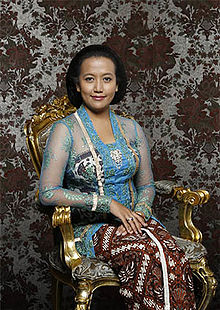 Javanese kebaya is a sheer blouse worn over batik kemben, as shown here worn by Princess Hayu of Yogyakarta. | |
| Type | Traditional upper garment |
|---|---|
| Place of origin | Maritime Southeast Asia (Indonesia[1][2][3][4] and Malaysia[3][4][5][6][7][8]) |
| Manufacturer | Javanese and Malay |
A kebaya[n 1] is an upper garment traditionally worn by women in Southeast Asia, notably in Brunei,[9] Indonesia,[10] Malaysia,[8] Singapore,[11] and Southern Thailand.[12] It is also worn in parts of southern Philippines and Cambodia.[13][14]
Kebaya is an upper garment opened at the front that is traditionally made from lightweight fabrics such as brocade, cotton, gauze, lace, or voile and sometimes adorned with embroidery. The front is secured with either buttons, pins, or brooches. The lower garment for the outfit is known as sarong, kemben or kain, a long piece of cloth wrapped and tucked around the waist or under the armpits, either made out of batik, ikat, songket or tenun.[n 2]
Kebaya is officially recognised as the national attire and the fashion icon of Indonesia,[10][15][16] although it is more popularly worn by Javanese, Sundanese, and Balinese people. In Malaysia, Singapore, and Brunei, it is recognized as one of its ethnic attires especially among Malay and Peranakan communities;[n 3] the complete outfit is known in these region as "sarong kebaya".[6] The styles of sarong kebaya vary from place to place throughout the region.
Kebaya has become a Southeast Asian fashion icon, with many Southeast Asian flag carrier airlines, including Singapore Airlines, Malaysia Airlines, Royal Brunei Airlines, and Garuda Indonesia adopting the traditional clothing as the uniforms for their female flight attendants.[17]
- ^ Steele, Valerie (2005). Steele Valerie (ed.). Encyclopedia of Clothing and Fashion. Charles Scribner's Sons. ISBN 978-0-684-31395-5.
- ^ Welters, Linda; Lillethun, Abby (2018-02-08). Fashion History: A Global View. Bloomsbury Publishing. ISBN 978-1-4742-5365-9.
- ^ a b Annette Lynch-Mitchell D. Strauss, ed. (2014-10-30). Ethnic Dress in the United States: A Cultural Encyclopedia. Rowman & Littlefield. ISBN 9780759121508.
- ^ a b Phromsuthirak, Maneepin; Chavalit, Maenmas (2000). Costumes in ASEAN Volume 1, Part 1 of ASEAN studies publication series. National ASEAN Committee on Culture and Information of Thailand. ISBN 9789747102833.
- ^ Setiawan, Ferry (2009). 50 Galeri Kebaya Eksotik Nan Cantik (in Indonesian). Niaga Swadaya. ISBN 9789793927909.
- ^ a b World Eco-Fiber & Textile (W.E.F.T) Forum 2003, Kuching, Sarawak, Malaysia. Atelier. 2002-09-19.
- ^ Forshee, Jill (2006). Culture and Customs of Indonesia. Greenwood Publishing Group. ISBN 9780313333392.
- ^ a b Cite error: The named reference
Haziyahwas invoked but never defined (see the help page). - ^ Cite error: The named reference
MuziumBruneiwas invoked but never defined (see the help page). - ^ a b "Kebaya: Identitas Nasional Indonesia". Research Center for Society and Culture, Indonesian Institute of Science (LIPI) (in Indonesian). 3 November 2020. Archived from the original on 12 February 2021.
- ^ Cite error: The named reference
Kohwas invoked but never defined (see the help page). - ^ "CHINESE HERITAGE ON THE WEST COAST OF SOUTHERN THAILAND: A HOLISTIC APPROACH TO IDENTIFICATION AND CONSERVATION" (PDF). Graduate School, Silpakorn University. 2018. Retrieved 29 November 2022.
- ^ "Tanailee". 19 July 2015.
- ^ Bhar, Supriya (1980). "SANDAKAN: Gun Running Village to Timber Centre, 1879-1979". Journal of the Malaysian Branch of the Royal Asiatic Society. 1 (237): 120–149. JSTOR 41493567.
- ^ "Women promote 'kebaya' wearing at MRT station". The Jakarta Post. Retrieved 2019-10-10.
- ^ Cite error: The named reference
Harsiantiwas invoked but never defined (see the help page). - ^ Khor, Samantha (23 March 2020). "The Origin of the Kebaya and How It Became an ASEAN Icon". www.ourdaily.co. Ourdaily. Retrieved 17 December 2020.[permanent dead link]
Cite error: There are <ref group=n> tags on this page, but the references will not show without a {{reflist|group=n}} template (see the help page).